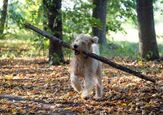Is Your Dog’s Vision Getting Cloudy? It Could Be Cataracts

If you’ve recently noticed your dog is starting to hesitate on the staircase they’ve climbed a thousand times before or bumping into the living room furniture that hasn’t moved in years, it’s only natural to worry. Your heart sinks a little as you wonder what’s wrong with your best friend.
These changes can be subtle at first, but they can be a sign of a larger issue with your dog’s vision. One of the most common causes of this kind of gradual change is a condition called cataracts.
In this post, I’ll explore what cataracts are, discuss the many reasons they may develop, and help you identify the signs. Most importantly, I’ll share the information you need to give your dog the best possible quality of life.
What Are Cataracts?
Let’s start with the basics: what exactly are cataracts? Imagine your dog’s eye is a tiny camera, and inside that camera, there’s a lens that focuses light onto the back of the eye to create an image. In a healthy eye, this lens is perfectly clear and allows light to pass through without any obstruction. A cataract is a clouding of the lens.
When looking at your dog, the cloudiness may look like a smudge or fog stretching across the eye and covering your view of the iris. This cloudiness is caused by the proteins in the lens clumping together, which prevents light from passing through properly. As the condition progresses, the cloudiness becomes denser, blocking even more light.
In the early stages, the cloudiness will cause your dog’s vision to be blurry. However, if it’s allowed to progress to a more advanced stage, it can lead to complete blindness.
Cataracts vs. Nuclear Sclerosis
If you have a senior dog whose eyes are starting to show a light haze, it’s easy to jump to the conclusion that it’s a cataract. This is a common concern, but it may be an age-related change called nuclear sclerosis.
Nuclear sclerosis is a natural hardening of the lens that happens with age, causing the eye to have a hazy, grayish appearance. Unlike cataracts, it typically doesn’t significantly impact their vision. A cataract, on the other hand, is a more opaque, milky-white clouding that limits the passage of light into the eye. Only a veterinarian can tell for sure which one your dog has.
Causes of Cataracts in Dogs
While we often associate cataracts with getting older, there are several reasons your dog may develop them (even at a younger age). Understanding the potential causes can help you take preventative steps and, where prevention isn’t possible, to prepare yourself to give your pup the best possible care.
Genetic Predisposition
One of the most common factors, and unfortunately not preventable, is your dog’s genetics. Just like in people, some dogs are simply more prone to developing cataracts due to their breed. Breeds like Poodles, Cocker Spaniels, Golden Retrievers, and Siberian Huskies are all at higher risk. If you know your dog’s lineage, it can give you a heads-up and a reason to be extra vigilant about any changes in their eye health, even from a young age.
Diabetes
This is a big one. Diabetes is the most common preventable cause of rapidly developing cataracts in dogs. The link is direct and powerful. When a dog has high blood sugar, it affects the chemical makeup of the eye’s lens. This causes it to swell and become cloudy very quickly.
Cataracts are often one of the first signs that a dog is suffering from undiagnosed diabetes. If your vet suspects the clouding is from cataracts, they will almost always test for diabetes as well.
Injury or Trauma to the Eye
A strike to the head, a scratch, or any kind of physical injury to the eye can cause significant damage to its delicate parts, including the lens. This trauma can impact the proteins within the lens, triggering the formation of a cataract. This is why it’s so important to be careful with your dog around things like sharp sticks and other potential hazards, or to use eye protection (like Rex Specs Goggles) when most at risk.
Other Potential Causes
While less common, there are other factors that can also contribute to the formation of cataracts. Chronic inflammation inside the eye, a condition known as uveitis, can damage the lens over time. In rare cases, especially in puppies, nutritional deficiencies can play a role, with the lens failing to develop properly. Ultimately, like with people, some cataracts are simply a part of the natural aging process, a gradual change that can happen to any dog as they get older.
Warning Signs to Watch Out For
Noticing that something might be wrong with your dog’s vision usually starts with subtle changes in their behavior. They can’t tell you that their vision is blurry, but their body language can help communicate that something is happening.
Subtle Behavioral Changes
These are often the earliest cues. You may notice your once active dog starts to hesitate before jumping onto their favorite spot on the couch or going up and down the stairs. They may seem a little confused, especially in new or dimly lit environments, possibly bumping into furniture or bumping into door frames that they use to navigate without any problems.
You may also see a change in their play, as they stop engaging in their favorite games like fetch or struggle to catch treats when tossed their way. Sometimes a dog may become more anxious or clingy when their vision starts to change, especially if they are in an unfamiliar space.
Physical Signs of Cataracts in Dogs
In addition to behavioral changes, especially as the condition escalates, you may be able to see physical signs in your dog’s eyes. This is why many veterinarians recommend that dog parents do regular eye checks at home, helping them catch subtle changes early.
When looking into your dog’s eye, look for a noticeable cloudy, milky-white, or bluish-gray appearance in one or both pupils. One or both pupils may not look as dark or black as they used to. While a hazy look can be a sign of nuclear sclerosis, a dense, opaque white appearance is a stronger indicator of a true cataract.
When to Contact Your Veterinarian
While most cataracts develop slowly, some situations call for immediate veterinary attention. If you notice any of these signs, you should contact your veterinarian as soon as possible:
- Sudden, complete blindness
- A red, painful, or swollen eye
- If your dog is squinting and tearing up
Ultimately, your dog’s eyes are delicate. Many conditions look similar but require different treatments, and only a veterinarian can give you a proper diagnosis using specialized tools and tests. An early and accurate diagnosis is the first step toward a successful treatment or management plan to keep your dog as comfortable as possible.
Options for Treatment and/or Management of Cataracts
After a diagnosis of cataracts, it's natural to be worried about your dog’s future. The good news is that you have options. A conversation with your veterinarian to collect information and answer questions is the best place to start. They will be able to assess the severity of the cataract and make recommendations for the best possible next steps based on your dog’s unique situation. In many cases, your vet may refer you to a veterinary ophthalmologist (eye specialist) who can provide a more in-depth level of knowledge about the condition.
Cataract Surgery
For many dogs, cataract surgery can actually restore their vision. The procedure, called phacoemulsification, is very similar to what humans undergo when faced with cataracts. It involves using a special instrument to break up and remove the cloudy lens. In most cases, the surgeon will then implant a clear, artificial lens in its place, allowing light to once again pass through effectively.
The success rate for cataract surgery is very high, but like any surgery, it is a decision that should not be taken lightly. A veterinary ophthalmologist will assess your dog’s specific case, considering both their overall health and the current condition of their eyes, and decide if they are a good candidate. If they believe surgery is a good option for your dog, it can truly be life-changing!
Non-Surgical Management
What if your dog isn’t deemed to be a good candidate for surgery? For some dogs, due to their age, other health conditions, or the type of cataract, surgery may not be recommended. This doesn’t mean you can’t help your dog live their best life. If surgery isn’t an option, the focus shifts to managing their quality of life, addressing the symptoms, and preventing any potential complications. For example, your vet may prescribe anti-inflammatory eye drops to address inflammation within your dog’s eye.
Supporting Your Visually Impaired Dog’s Quality of Life
It’s important to remember that a dog can still live a long, happy, fulfilled life with limited or no vision. Their happiness doesn’t depend solely on their sight. Their other senses, like smell, hearing, and touch, are powerful tools that they will learn to rely on to navigate the world. By making some simple adjustments to your home and lifestyle, you can create a safe, stimulating, and happy environment for your best friend.
Create a Secure Space
The number one priority is your dog’s safety and comfort. A dog who is learning to navigate the world with failing vision will thrive best in a predictable home environment. This means keeping your home layout consistent, not rearranging furniture or making changes to the spaces they have access to.
Over time, your dog will create a mental map of their space, allowing them to move safely through your home. Changing this layout that they have learned can create confusion, frustration, and may even lead to injury. If you do have to move something, take the time to guide them through the space several times, teaching them the new updated layout.
Protect your pup from potentially unsafe spaces like staircases or uneven floors using barriers like a safety gate or dog exercise pens.
If you are taking your dog outside, especially in an unfenced yard, or into any new and unfamiliar spaces, make sure your dog is always leashed. This will help you guide them if needed and prevent them from bumping into things or wandering off into trouble.
Engage Their Other Senses
When your dog’s vision fails, their other sense can be used to boost their confidence, keep their minds active, and help them navigate their environment.
When training your dog, try using vocal cues. This extends beyond basic obedience style cues. By using verbal cues like “wait” or “step up,” you can help your dog move safely through any space. You may also benefit from the use of a training clicker or a dog whistle during training.
For playtime, consider using sound-based toys like squeaky toys or crinkle balls to make things more engaging. You can also leverage their strong sense of smell by hiding treats around the room to sniff out or using a snuffle mat. There are also scented toys that introduce fun smells into their play.
Emotional Support and Routine
Consistency and routine are important for any dog, especially those who are trying to adapt to such a significant change. Create and stick to a predictable schedule for walks, meals, and playtime. This will help them feel more secure as they always know what to expect next.
Your dog also relies on you for emotional support and comfort. Use your voice and gentle touches to reassure them if you notice that they are stressed or anxious.
By focusing on these areas, you’re not just managing their vision loss; you’re helping your dog learn to navigate their “new normal” while also strengthening the bond you share in a new and meaningful way.
Moving Forward Together
No matter the path you choose, whether it’s through surgical intervention or by adapting to a new normal, the most important factor is your dog’s well-being. You play a key role in that, offering the support, compassion, and care they need on this journey. Trust your instincts and don’t hesitate to reach out to your veterinarian with any questions or concerns. Remember: even with vision loss, you pup can continue to live an incredible life by your side.
Join the PetGuide community. Get the latest pet news and product recommendations by subscribing to our newsletter here.

Britt Kascjak is a proud pet mom, sharing her heart (and her home) with her “pack” which includes her husband John, their 2 dogs – Lucifer and Willow – and their 3 cats – Pippen, Jinx, and Theia. She has been active in the animal rescue community for over 15 years, volunteering, fostering and advocating for organizations across Canada and the US. In her free time, she enjoys traveling around the country camping, hiking, and canoeing with her pets.
More by Britt
























